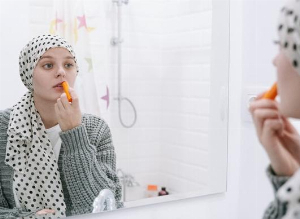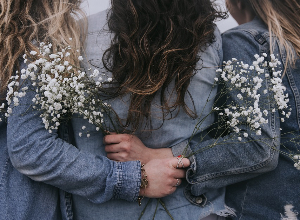Beauty Tips to Fight against Breast Cancer!
Published Jan 19, 2021 • By Gilda Teissier
The ability to feel like yourself can be one of the most effective treatments of all. That's why, when fighting breast cancer, it is really important to be able to maintain some of your old habits, such as one's beauty routine. Beauty and skincare routines can be some of the most satisfying forms of self-care.
So, how can you match your former skin tone? Which false eyelashes should you use and how? How to take care of your skin and nails?
We tell you everything and more in our article!

Breast cancer is a type of cancer that mainly affects women and develops from breast tissue. It occurs when cells begin to reproduce uncontrollably due to mutations and eventually form a tumor of infected cells. It is treated in several ways and depends on the kind of breast cancer and how far it has spread.
Treatments can involve:
- Surgery
- Chemotherapy
- Hormone therapy
- Targeted (biological) therapy
- Radiotherapy
Whatever the treatment or series of treatments followed, the body will be affected in different ways: hair loss, change in skin tone, loss of fingernails, rashes, etc. If it is difficult to feel good about oneself and feel comfortable in one's own skin in a normal situation, it becomes even more difficult when undergoing treatment.
The goal here is not to become supermodels worried only about their looks, when battling cancer is a full time job as it is. Rather, as make-up artist and author Ramy Gafni says it's “about looking like yourself before you started treatment”. Studies have shown that self-care has psychological benefits and can help lift one's spirits and help one to feel a bit better despite all the challenges that cancer treatment can bring.
Beauty Tips:
Hair plays a huge part in shaping identity and in the way we present ourselves visually to the world. Knowing that you can lose it because of cancer treatment can be a real trauma.
Here are some tips for hair, eyebrows and eyelashes:
 Hair: Not all types of chemotherapy cause hair loss, some treatments may only cause hair thinning. There are some remedies that can either reduce hair loss or simply make you and your scalp feel better:
Hair: Not all types of chemotherapy cause hair loss, some treatments may only cause hair thinning. There are some remedies that can either reduce hair loss or simply make you and your scalp feel better:
- Scalp cooling: it is a technique that may help reduce hair loss. It uses cold to constrict blood vessels, which reduces blood flow to the scalp, thus decreasing the passage of treatment molecules into the hair follicles. This helps protect the hair cells and may also help promote regrowth.
- Brush gently: sometimes the problem is not going bald, but simply thinning of the hair. In this case, you want to brush your hair properly to avoid causing it to fall out or become more damaged. A good technique is using a wide-tooth comb on dry hair, placing one hand just below the roots and, with the other hand, running the comb slowly and gently through the hair to the ends.
- Wash your hair less: Try to wait two weeks between shampoos. This way, you'll keep the nourishing oils that your scalp needs longer. Also try to use shampoos that are free of fragrances, parabens and silicones.
- Opt for a wig: this is a very personal choice, and it can also be a chance to try a look you’ve always wanted. Wearing one can also prevent unsolicited comments or advice. Just don’t forget a wig cap, which will protect your scalp from the wig’s itchy underside.
 Brows: When you lose your brows, it can feel as though the face looking back at you in the mirror is no longer your own. While you’re waiting for your eyebrows to grow back, using brow products such as pomades, powders, pencils and stencils can help. Some women even pre-plan this type of thing and get their brows tattooed on before chemotherapy. If you go for a pencil, a wax-based pencil can be your best option because it will stay in place even if you suffer hot flashes during treatment.
Brows: When you lose your brows, it can feel as though the face looking back at you in the mirror is no longer your own. While you’re waiting for your eyebrows to grow back, using brow products such as pomades, powders, pencils and stencils can help. Some women even pre-plan this type of thing and get their brows tattooed on before chemotherapy. If you go for a pencil, a wax-based pencil can be your best option because it will stay in place even if you suffer hot flashes during treatment.
Here is a short tutorial created by Breast Cancer Now, which shows how to draw on your brows:
 Eyelashes: You can use false lashes to fill in gaps while yours grow back. Eyelash growth serums can also help you grow them back faster and healthier. If you don’t know how to properly apply fake eyelashes (like most of us) you can follow this fantastic tutorial created by Breast Cancer Now:
Eyelashes: You can use false lashes to fill in gaps while yours grow back. Eyelash growth serums can also help you grow them back faster and healthier. If you don’t know how to properly apply fake eyelashes (like most of us) you can follow this fantastic tutorial created by Breast Cancer Now:
Make-up, nails and skin routines are also an important part of feeling like your old self and taking care of you.
 Lipstick and blush: One survivor says, “I lost all the color in my face, so I went and bought a bunch of bright lipsticks which made me feel way better”. If you feel like it, wearing lipstick and blush can help you regain some color and confidence at the same time. Choose products without chemicals or scent and that have a creamy texture.
Lipstick and blush: One survivor says, “I lost all the color in my face, so I went and bought a bunch of bright lipsticks which made me feel way better”. If you feel like it, wearing lipstick and blush can help you regain some color and confidence at the same time. Choose products without chemicals or scent and that have a creamy texture.
 Foundation: Skin texture and color may change during treatment, but with the right foundation you can cover it up. First be sure to choose one that has a fluid texture. The trick is to apply your moisturizer and sunscreen first, then your foundation. It will help even out your face’s color and give you a natural glow, if you choose to go for a dewy one. You can either choose to stop there, or it can also be a good base for the rest of your makeup if you want to do more.
Foundation: Skin texture and color may change during treatment, but with the right foundation you can cover it up. First be sure to choose one that has a fluid texture. The trick is to apply your moisturizer and sunscreen first, then your foundation. It will help even out your face’s color and give you a natural glow, if you choose to go for a dewy one. You can either choose to stop there, or it can also be a good base for the rest of your makeup if you want to do more.
 Concealer: If you want to erase shadowy under-eye circles, spot-cover a blemish, or help sculpt your cheekbones—concealer is the product that does the trick. Opt for one with yellow undertones, which neutralizes purple tones and is the best for covering dark spots. Color correctors are also an option. Once again, make sure it is creamy and moisturizing, this will avoid a lot of unnecessary rubbing to apply.
Concealer: If you want to erase shadowy under-eye circles, spot-cover a blemish, or help sculpt your cheekbones—concealer is the product that does the trick. Opt for one with yellow undertones, which neutralizes purple tones and is the best for covering dark spots. Color correctors are also an option. Once again, make sure it is creamy and moisturizing, this will avoid a lot of unnecessary rubbing to apply.
 Nails: Chemotherapy, especially chemotherapy using taxane (such as Taxotere), can inflame nail beds to the point of redness and swelling and can make your nails drier, more brittle and fragile. The nails themselves can become discolored or develop grooves or ridges, and in the worst case, become detached. To prevent infection, you can give your nails a daily antibacterial soak. In a bowl, mix equal parts water and distilled white vinegar; soak nails for 10 to 15 minutes. If you want to paint them, go ahead, but choose a water-based varnish.
Nails: Chemotherapy, especially chemotherapy using taxane (such as Taxotere), can inflame nail beds to the point of redness and swelling and can make your nails drier, more brittle and fragile. The nails themselves can become discolored or develop grooves or ridges, and in the worst case, become detached. To prevent infection, you can give your nails a daily antibacterial soak. In a bowl, mix equal parts water and distilled white vinegar; soak nails for 10 to 15 minutes. If you want to paint them, go ahead, but choose a water-based varnish.
 Moisturizers: Chemotherapies tend to damage the skin and it is essential to keep it healthy and hydrated. This is mainly because dry skin can cause skin breakage, flaking, infection or itching that can interfere with one's rest.
Moisturizers: Chemotherapies tend to damage the skin and it is essential to keep it healthy and hydrated. This is mainly because dry skin can cause skin breakage, flaking, infection or itching that can interfere with one's rest.
- If you have acne you can try topical antibiotics or steroids that can reduce inflammation and speed healing.
- If you have dry patches or a rash, try coconut or olive oil. These are not only healthy kitchen staples, they are also great multipurpose moisturizers. They can be applied head-to-toe and work wonders on dry, patchy skin.
Which tip did you like the most? Do you have any other tips that we didn't mention?
Feel free to share with the community in the comments below!
Take care!

 Facebook
Facebook Twitter
Twitter


